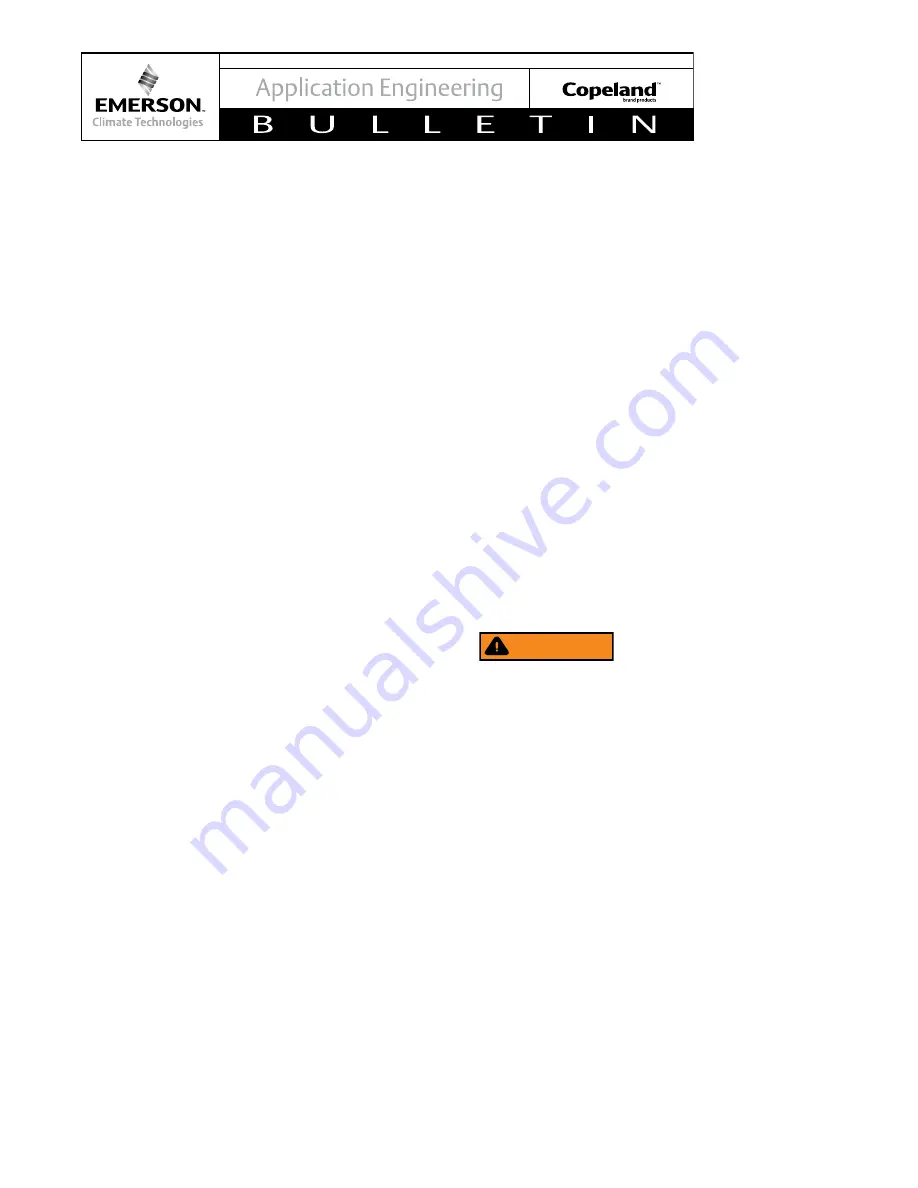
11
© 2016 Emerson Climate Technologies, Inc.
AE4-1402 R4
manifolded set are operating and if the manifolded set
is made up of equal or unequal compressor capacities.
Because of the unequal oil levels that can exist, oil
levels should be viewed with the compressors off to
allow the oil level to stabilize between the compressor
sumps. With the compressors off, oil should be visible
in the individual compressor sight-glasses.
Suction and discharge manifolds are not designed
to support system piping. Support means must be
provided by the system designer to support suction
and discharge lines so that stress is not placed on
the manifolds.
The compressors in a manifolded set can be started/
stopped in any desired sequence. To help reduce
inrush current, starting the compressors individually is
recommended. Should a compressor fail in the tandem
set the complete tandem should be removed from the
unit and replaced with a new tandem set. Replacing
individual compressors is discouraged because of
the care that must be used when installing the oil
equalization tube and the availability of manifolds to
the aftermarket.
Please consult with Application Engineering during
the development of systems with trio compressor
assemblies. Trio compressor assemblies are
sensitive to system operating conditions and
configurations which will affect oil balancing. Trio
compressor assemblies must be qualified for each
application.
Manifolded compressor assemblies are available
for purchase from Emerson. In lieu of purchasing
the assembled tandem, the OEM has the option to
purchase the tandem-ready compressors to assemble
the compressors into a tandem configuration.
Drawings of the tandem manifolds are available
by contacting your application engineer. Manifold
ready compressors are designated with a -4XX bill of
material number at the end of the model number (e.g.
ZPV0631E-4X9-455).
Customers that choose to
design and build their own manifolds for tandem
and trio compressors are ultimately responsible
for the reliability of those manifold sets.
APPLICATION TESTS
New system designs should be evaluated throughout
the entire expected operating range of the unit to
ensure the system will perform reliably throughout
the life of the product. Test data, taken throughout
the operating range of the unit, should be closely
scrutinized to help identify gross errors in system
design that may produce conditions that could lead to
compressor failure.
General Application Tests
In addition to the tests outlined above, off-cycle
migration tests are recommended if the system charge
amount exceeds 11 pounds (7 kg) and less than 100
watts of the stator heat option is selected. The purpose
of the off-cycle migration test is to ensure that stator
heat is great enough to minimize off-cycle migration
after long compressor 'off' periods. System faults, such
as low or loss of indoor air-flow, loss of outdoor air-flow,
and low/overcharge conditions should all be evaluated
to ensure the compressor and service technician are
protected against any adverse condition.
NOTICE The tests outlined above are for common
applications of compressors in this family.
Please consult with Application Engineering on
applications outside of those outlined above for
the appropriate application tests.
ASSEMBLY LINE PROCEDURES
Installing the Compressor
WARNING
Use care and the appropriate material
handling equipment when lifting and moving
compressors. Personal safety equipment must
be used.
Copeland Scroll compressors leave the factory
dehydrated, with a dry air holding charge. If
compressors are stored in a cold ambient (i.e. outside
during the winter), the suction and discharge plugs
should not be removed until the compressor has
had sufficient time to warm up to the plant ambient
temperature. The suggested warm up time is one
hour per 4°F (2°C) difference between outdoor and
indoor temperature. It is suggested that the larger
suction plug be removed first to relieve the internal
pressure. Removing the smaller discharge plug could
result in a spray of oil out of this fitting since some
oil accumulates in the head of the compressor after
Emerson’s run test. The inside of both fittings should
be wiped with a lint free cloth to remove residual oil
prior to brazing. A compressor containing POE oil
should never be left open longer than 20 minutes.









































